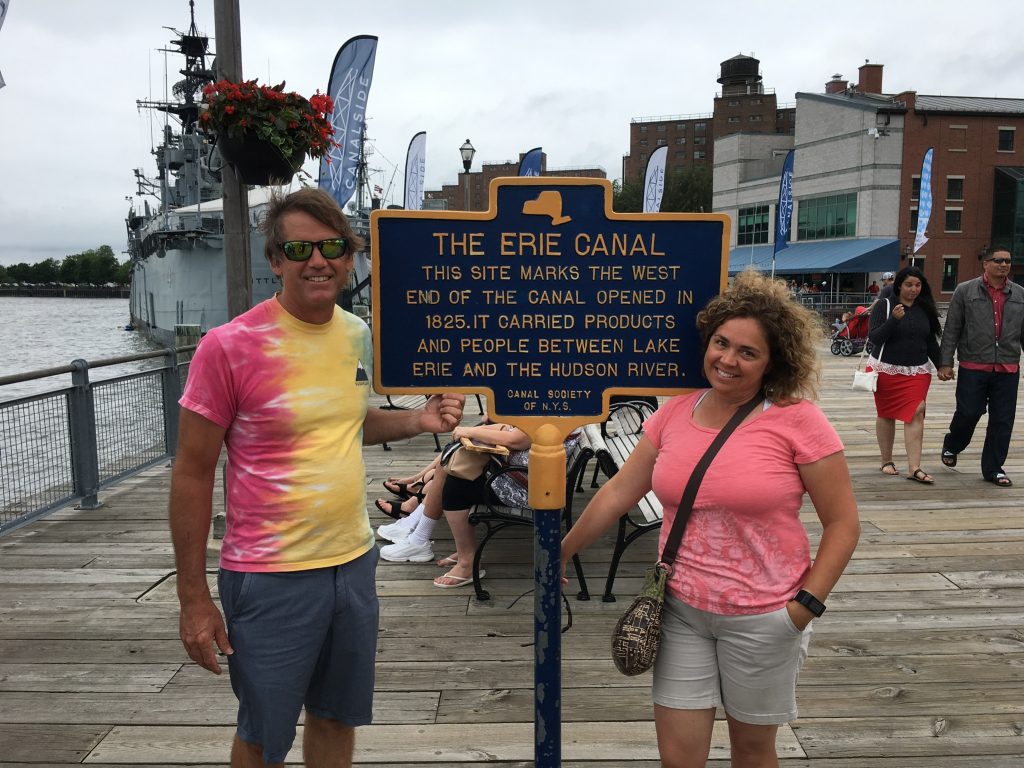
We have finished the Erie Canal and we’ve stepped our mast so Thalia can regain her pride as a sailing vessel as she leaves the Erie Canal in her wake and tips her bow into the first of the Great Lakes – Lake Erie!
Erie Canal by the numbers – The Erie Canal is 338 miles long, has 34 locks that lifted for a total of 420 feet of elevation, there are 16 lift bridges that needed to open for us (all from Fairport to Lockport in the western section), and too many quaint upstate New York towns to mention! We will mention our favorite, however, and that is the lovely Pittsford!
Our final over-night stops on the Erie Canal were in Brockport, Lockport and then Tonawanda – the current western terminus of the Erie Canal!
The Western section of the Erie Canal is quite different in that the engineers who designed and built the current structures dedicated a lot of resources toward keeping the canal at the high elevation it had gotten to in the Eastern and Central sections. The alternative would have been adding down-locks and additional up-locks to accommodate the rolling landscape of western New York. The ultimate elevation for the canal to end at (going in our East-to-West direction) is the elevation of Lake Erie which is 100 feet higher than we were at before this blog post (in Pittsford). We have four locks remaining (E32 – E35) and each lift is right around 25 feet.
Engineering Feats
For a little over a mile in the western section of the Erie, they built up banks to support the series of canal walls that would retain the canal elevation. When we passed through this area, we could look down as much as 70 feet on each side of the canal to the fields and neighborhoods below! This structure is called ‘The Great Embankment’. There are also places where water from spillways (which are located at regular intervals along the canal to help maintain desired water levels) is redirected back under the canal to join other tributaries. There is also a road that passes underneath the canal in this western section. Water from the canal is said to leak onto the cars passing through the tunnel. Finally, there is the challenge of lifting boats up 50 feet in a short lateral span to get over the rock formation known as ‘The Niagara Escarpment’. This final lift brings the boats up to just 5 feet of elevation below the surface of Lake Erie.
All of these engineering marvels are impressive and even more so when you consider that most of the structures were imagined, designed and built at least one hundred years ago and have seen only periodic maintenance since. Yes, this did often enter my thoughts as our boat passed by each of these wonders! However, the single most hair-raising experience was pulling into Medina harbor to realize the entire harbor was essentially held in place against a slight hill in this town by a man-made, raised concrete canal wall. The structure looked similar to how a dam holds back the water upstream. I couldn’t even look over the side to see how far down the real land was but I later learned it was 70 feet down at the max wall height! The strange thing was that this constructed harbor wasn’t expounded upon in any of the materials we had so we came upon this and were shocked to see we were significantly elevated above the surrounding land on the down-hill side and were in a pretty sizable harbor to boot! I was driving and I got the heebbie-jeebbies so badly that I had to have Tom take the wheel. To think we almost picked this location to spend the night – all I wanted to do was get the heck out of there! Even so, the engineer in me was impressed. Freaked out, but certainly impressed.
Lockport is the town that came into being in the area chosen to take boats over the Niagara Escarpment and it deserves the name it chose! The previous version of the Erie Canal (before the early 1900s) had five back-to-back locks lifting (and lowering) boats over the 50 foot escarpment at this location. The State of New York has preserved and restored much of these locks which were known as the ‘Flight of Five’ and they nicely maintain the grounds around these old locks which are adjacent to their replacements! Lockport now has two back-to-back locks that each have a 25-foot lift. After the first lock’s water level has been raised, the door between the two locks is opened and you pass directly into the second lock for the final lift on the Erie Canal! Check out the video of us passing through this double lock.
The night before we navigated the locks, we walked the grounds. Tom flew the drone over the old ‘Flight of Five’ locks before he learned he wasn’t supposed to! The footage is great, though, so check it out. As the drone flies toward the locks, the first pass is a high pass to give you perspective. After the first minute or so the drone drops elevation and you can see more detail. The left side caverns are the locks in use today and the skinny lock steps on the right are the locks in use prior to the early 1900’s.
The water color changed dramatically after we passed out of the Lockport double locks and we realized we were probably seeing the water color of Lake Erie and the Niagara River! Yippee. We made it to the town of Tonawanda and to the place where we were to have our mast stepped by noon on Friday, June 30. We were deep into rigging for the rest of the afternoon and evening.
Stepping Our Mast
We wanted to use almost any service to help us step our mast except for Wardell Boat Yard but no other place returned our calls during this busy time and we needed to move on so we called Wardell’s. Tom and I did nearly all of the work. Wardell ran the crane and not much else. We certainly did all of the heavy lifting and by day’s end we had an erect mast but were thoroughly exhausted and more than a little frustrated at the lack of skill and equipment available to assist. Check out the pix from this day below. Take note of the ‘crane’. This must have been a turn of the century model (19th century!). The operator had asphalt roofing tiles and sand bags piled around and below his crane’s engine to add weight for balancing against lifting heavy masts! Imagine. The crane had no lateral movement – any time we needed the mast to go forward or back we needed to move the BOAT! Here are the tasks we had to accomplish to step the mast and rig our boat for sailing:
- Take down bimini and dodger (canvas coverings that provide sun and weather shelter). Since the mast sits very close to these on the deck, we want to make sure there is no damage so we dismantled both.
- Untie mast/boom/radar pole from stands on the deck
- Move all rigging onto the shore and remove the stands from the deck
- Install two pair of spreaders (the bars that protrude perpendicular to the mast and hold the stays away from the mast and give the mast strength)
- Install antennas, instruments and lights on the mast head
- Assemble a harness to lift the mast and the associated stays and lines with the crane
- Lift the mast into place then secure it with forestay, then side stays, then back stay.
- Tighten all stays
- Re-install bimini and dodger
- Install boom and run all corresponding lines
- Install radar pole on backstay
- Run wiring from bottom of mast through the deck and connect wires for lights, wind direction, wind speed, vhf radio antennae and radar. Test all of these systems.
- Run all lines into the cockpit (halyards, topping lift, outhaul, reefing lines, etc.)
- Raise main and jib sail and furl them so they are ready for use
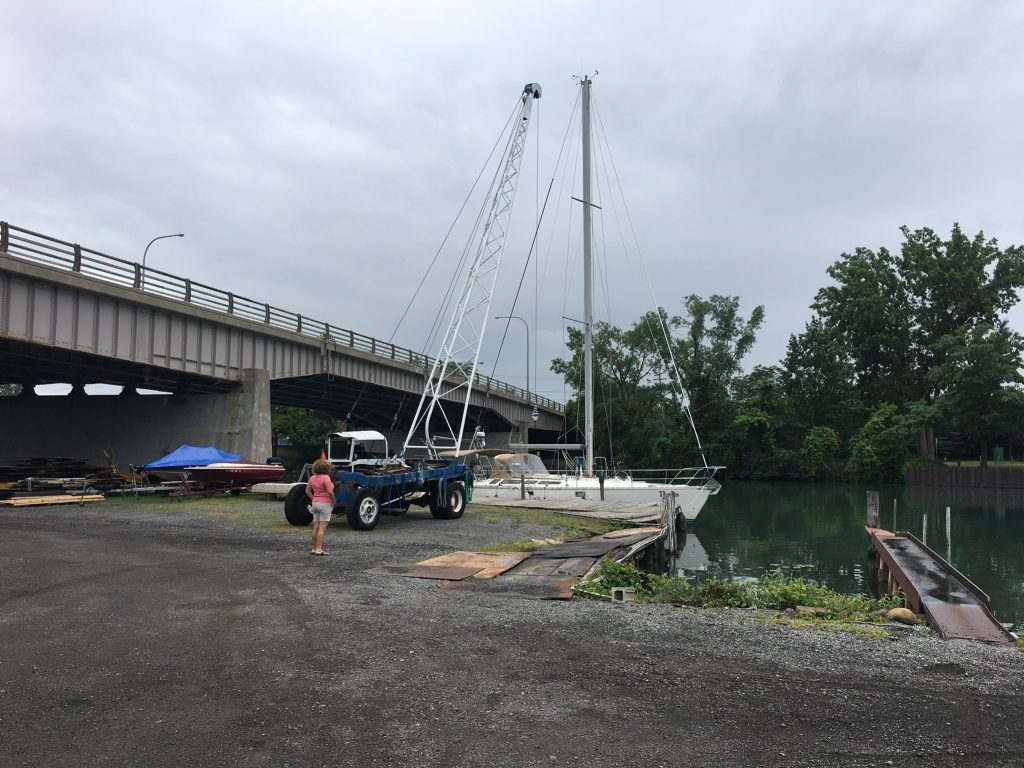
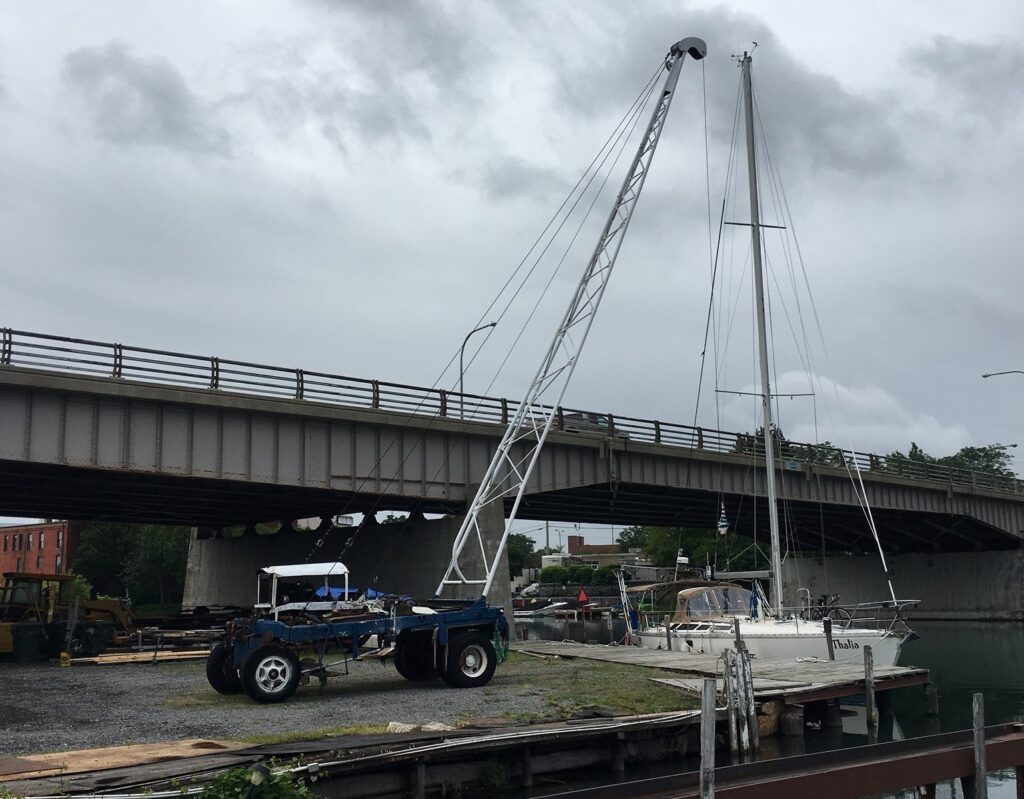
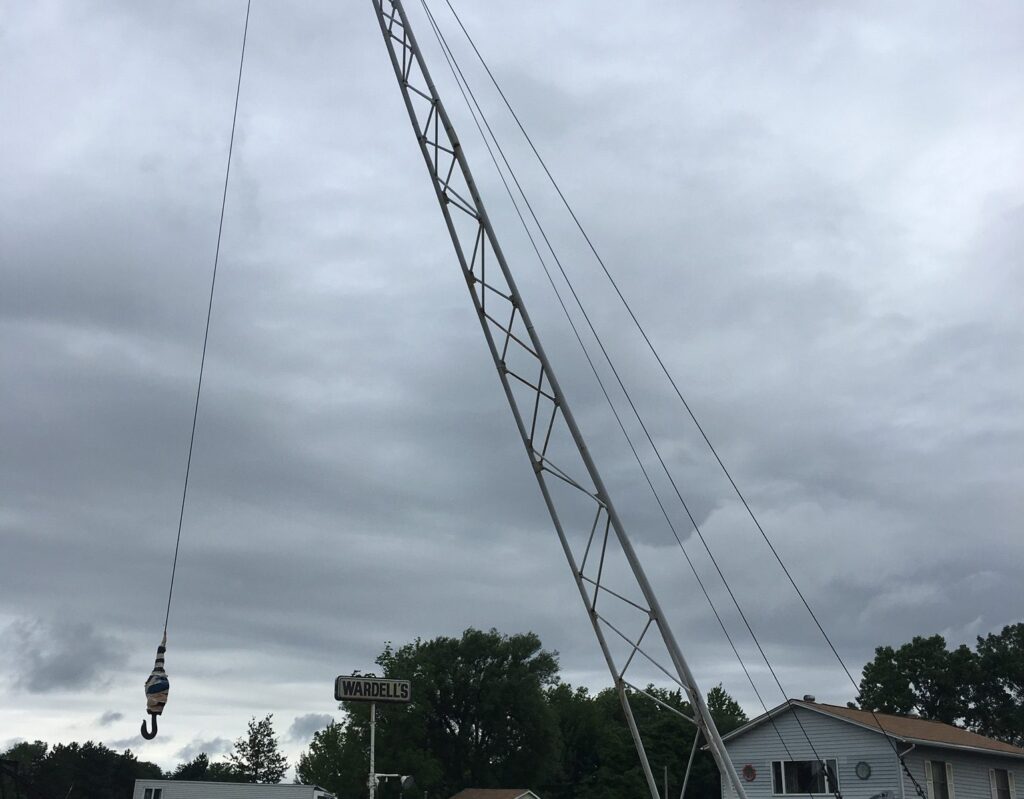
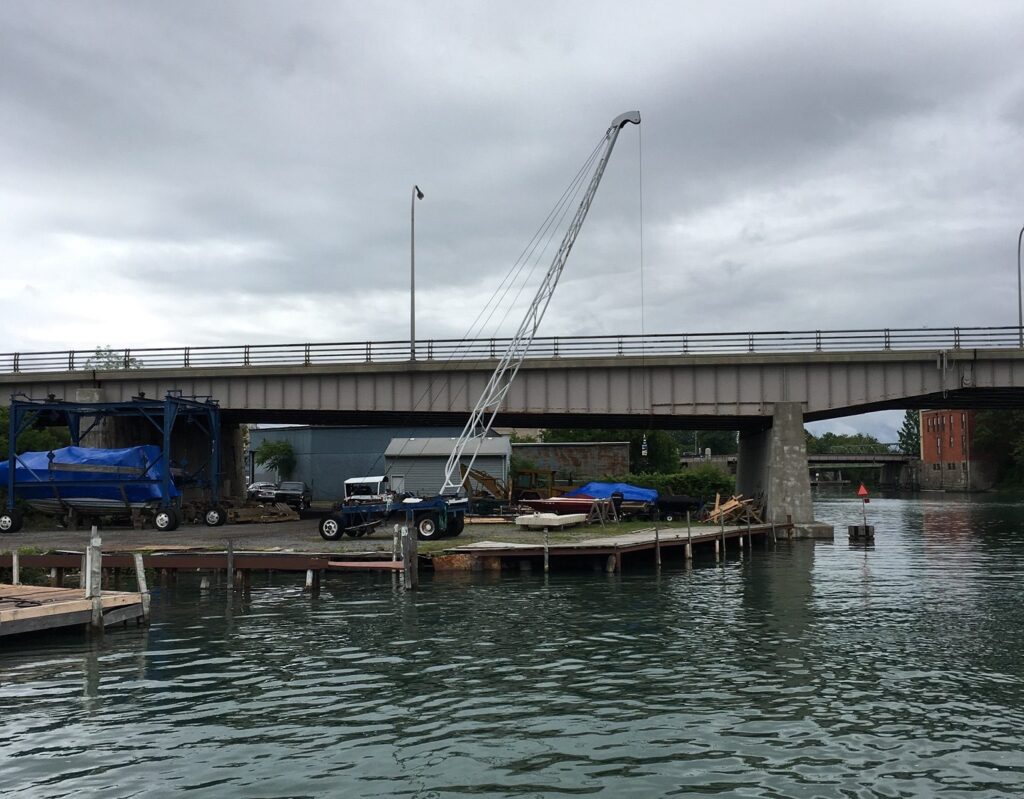
Now that we were a sailboat again, we were eager to make our way to Buffalo. It was nearly July 4th and we knew ‘Canalside’, where we hoped to spend a couple days, would be a popular destination for boaters leading up to the holiday! Buffalo is only 12 miles from Tonawanda and luckily we had this helpful sign show us the way.
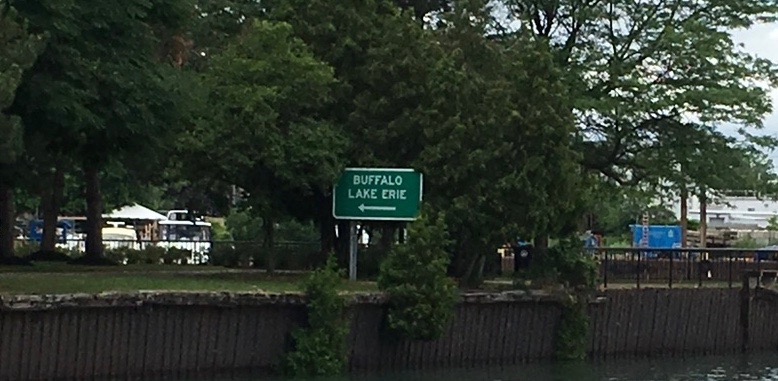
Instead, we went against the current of the Niagara River toward Buffalo. Watch this quick video by Tom to see the wide and swift Niagara River and to learn about Black Rock Canal.
Buffalo’s ‘Canalside’ is urban development done very well! During excavation for a portion of what is now the wonderfully popular Buffalo waterfront, remnants of the original canal terminus walls were uncovered, having been filled in decades earlier. This discovery sparked years of debate … should the town establish a park around this amazing time in Buffalo’s history or leave it in the past? Luckily, the city of Buffalo stepped up and did a beautiful job unearthing not only the final yards of the stone block walls that made the canal, but also a series of foundations of storage/loading buildings used in the time when Buffalo was the epicenter for grain shipment from the mid-west to the rest of the US and to the world. They once again routed water through this revived canal and built a walking bridge over it that replicated the many exchange bridges that allowed mules to complete their 15 mile circuit from their home towns. Mules would leave their stables in the morning and pull cargo in one direction until they reached their bridge. Their human tender would then exchange their barge for a barge heading back the other direction and so the mule pulled this new load back to where a night’s rest was allowed. It is very special to have an exchange bridge be a part of Buffalo’s canal preservation effort.
The Canalside developers added some waterfalls to mimic the changing water levels made possible by the numerous canal locks and surrounded this presentation with nicely landscaped open space and a boardwalk that connects this area to the rest of the public access trails and parks that stretch along Buffalo’s now expansive waterfront. A long public dock that boaters can use on a first-come basis stretches along the boardwalk and this is where we spent the days leading up to the 4th of July. If you visit Buffalo, be sure to include a trip to Canalside.
Great job Buffalo! Canalside is a heavily used and immensely enjoyed asset that you should be proud of. It celebrates the history of Buffalo and especially the fact that Buffalo was the western terminus of the Erie Canal. Today, the Erie Canal is officially terminated in Tonawanda, New York where the boater is directed into Tonawanda Creek and then into the Niagara River, which is fed from Lake Erie right at Buffalo. The ‘Black Rock Canal’ was constructed along the eastern side of Niagara River to allow boaters to by-pass the extreme current in the Niagara at its narrow points.
We spent three nights on the dock at Canalside and enjoyed the lively, urban feel. We did a bunch of errands and random work on the boat but mixed it up with fun bike rides and walks along the waterfront. We even rented a car to allow Tom to see both the Canadian and US sides of the powerful Niagara Falls.
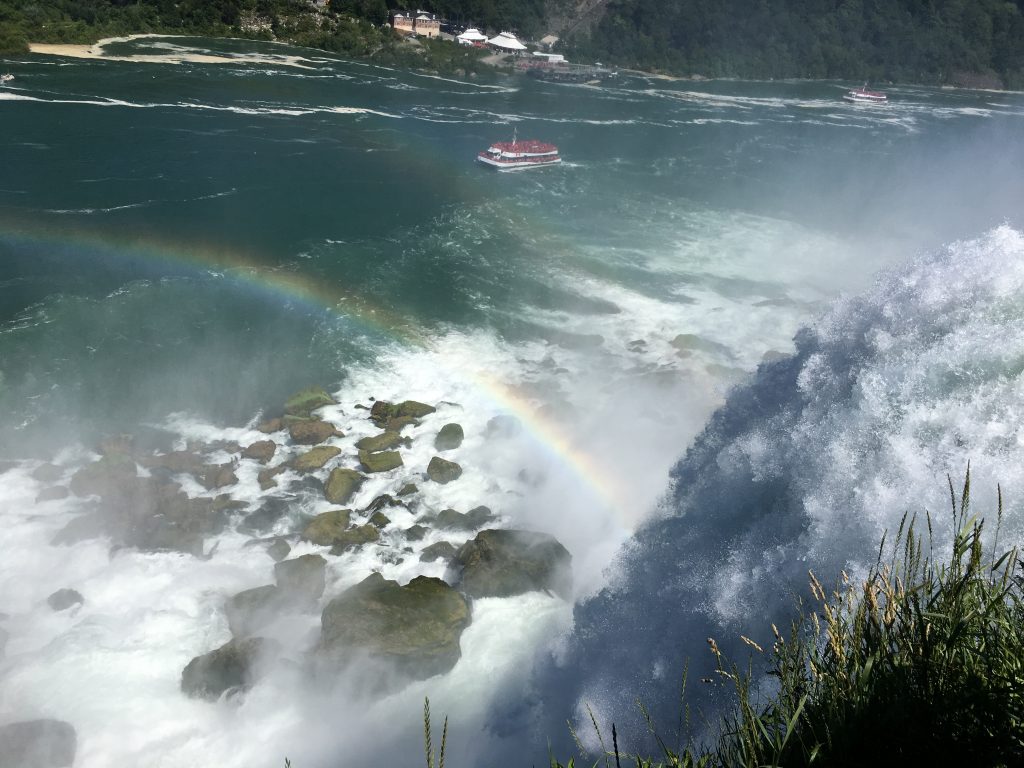

Great Lakes
We departed Buffalo Harbor early on the morning of July 4th, having gotten the weather window we were hoping for. Lake Erie is huge in terms of surface area but is extremely shallow for a body of water this large. When the wind kicks up, the shallowness encourages the creation of steep waves that come very close together. For this reason, Lake Erie is considered one of the most dangerous of the Great Lakes. Most boaters plan lake crossings carefully since the great distance (185 miles from Buffalo to Vermilion) gives changing weather plenty of time to create chaos on the water as boaters make their way across! When wind is going in the same direction as your boat, the waves are not quite as choppy so with easterly winds predicted we are off across the lake!
Barely out of the Buffalo Harbor, we got overrun with BUGS! I thought bugs were bad in New Hampshire but this is crazy. Apparently, the bug invasion we experienced while in Little Falls, NY (on the Erie Canal) were ‘May Flies’ – although they typically show up in June. I guess the May Flies are so bad in cities and towns along the south coast of Lake Erie that there is a web site that tracks first sightings each year and their swarming can often be seen on radar images since these bugs hatch pretty much all around the same time! The bugs we had invading us yesterday were not May Flies. As best as I could tell from my google searching, these were ‘Midges’. However, I’m not convinced since the word on the street is that Midges typically show up on the scene before May Flies. Regardless, they COVERED our boat … everywhere! Luckily they don’t bite but they are annoying AND, they brought with them biting black flies that wanted to eat the quickly dying midges (and us). Throughout the difficult day, both Tom and I thought independently about altering our trip plans drastically by heading up into Lake Ontario and out toward Thousand Islands. We didn’t share this fact with one another until consuming a bottle of wine at the end of a swim in the lake and a wonderful sunset.

This morning we scrubbed the boat bow to stern both above and below deck hoping this would encourage the biting flies to seek tastier environs. The midges from the previous day were largely gone. It’s nice to have the boat spanking clean but the flies are sticking around. At this point, we are still moving forward but the black biting flies are nearly unbearable even 10 miles out into the lake. It doesn’t matter how many we kill either … ugh … hoping this improves. Research tells me that the biting bastards are called ‘stable flies’ or ‘dog flies’ and that they are related to the common house fly but a bit smaller and both genders bite aggressively (which I didn’t need research to confirm). Accounts of these pests say they disappear as quickly as they show up, so here’s to hoping!
We will travel along the southern shore of Lake Erie and expect the trip to take three full days and likely a portion of a fourth. Tune in next week to see if we have become Lord of the Flies!!

Totally interesting. I can’t imagine being in flies that thick. In studying history I don’ t remember that the Erie canal was so long and that it would take so much work to get through. I’m sure you will enjoy having your mast up. I like the picture of both of you at Niagara Falls. Second Honeymoon? Keep the letters coming, very enjoyable.
Enjoying your pictures and description of the Erie Canal. Doesn’t sound like Lake Erie itself will compare.
Thanks Martin. We”ll update the blog soon on Lake Erie but it was definitely a contrast with the canal. All better than a day at the office though!